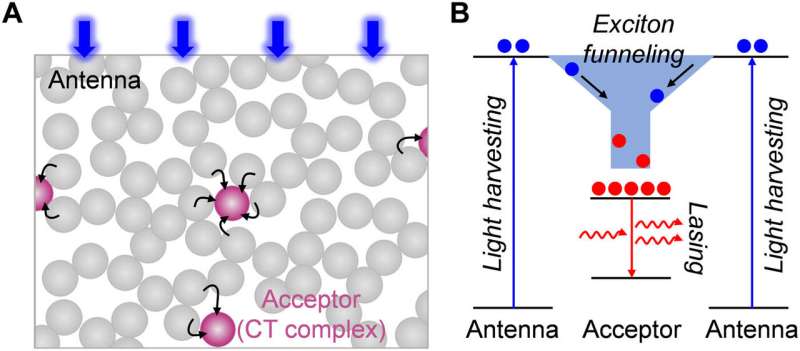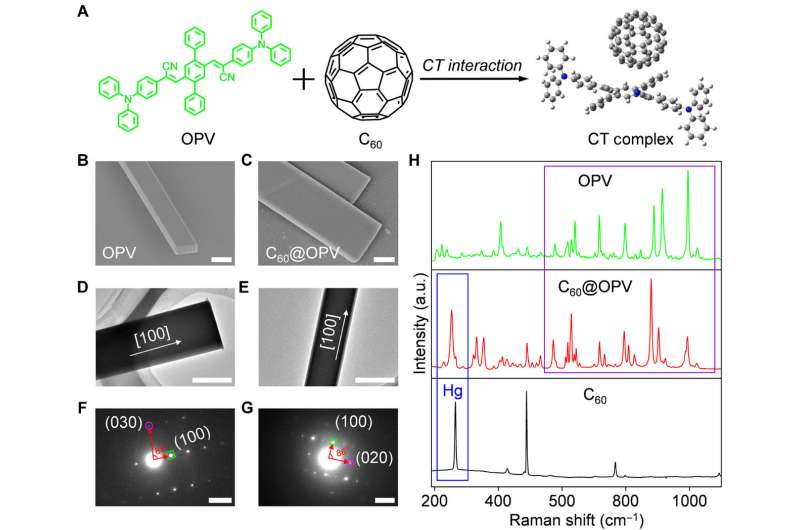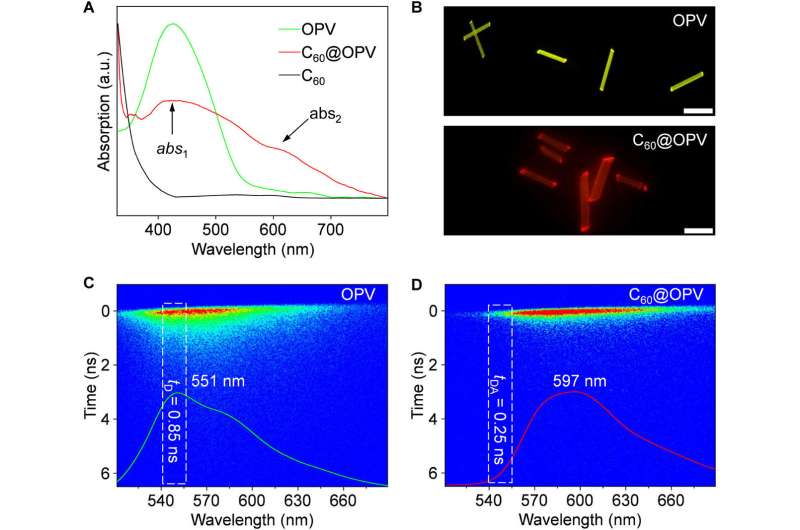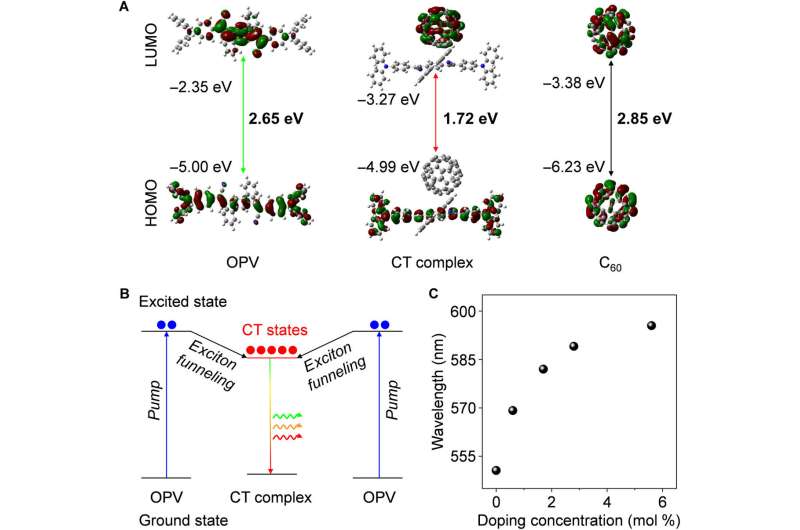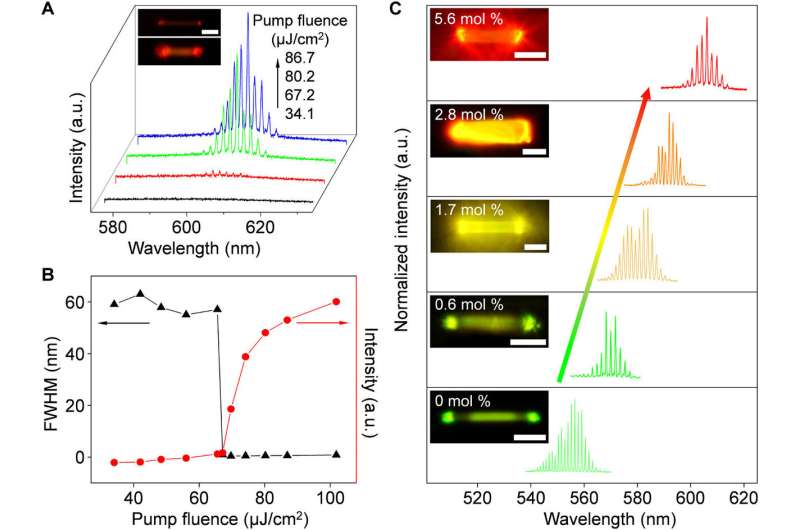Illustration for exciton funneling in the light-harvesting systems. (A) Schematics of light harvesting, where the wide-bandgap hosts (gray spheres) act as antenna and locally formed CT complexes with narrow bandgap (pink spheres) act as acceptor. (B) Diagram for exciton funneling in light-harvesting systems. The black arrows represent the exciton transfer process. Credit: Science Advances, doi: 10.1126/sciadv.aaw2953
Organic solid-state lasers are essential for photonic applications, but current-driven lasers are a great challenge to develop in applied physics and materials science. While it is possible to create charge transfer complexes (i.e. electron-donor-acceptor complexes among two/more molecules or across a large molecule) with p-/n- type organic semiconductors in electrically pumped lasers, the existing difficulties arise from nonradiative loss due to the delocalized states of charge transfer (CT). In a recent report, Kang Wang and a team of researchers in the departments of chemistry, molecular nanostructure and nanotechnology in China demonstrated the enduring action of CT complexes by exciton funneling in p-type organic microcrystals with n-type doping.
They surrounded locally formed CT complexes containing narrow bandgaps with hosts of high levels of energy to behave as artificial light-harvesting systems. They captured the resulting excitation light energy using hosts to deliver to the CT complexes for their function as exciton funnels in order to benefit lasing actions. Wang et al. expect the preliminary results to offer in depth understanding of exciton funneling in light-harvesting systems to develop high-performance organic lasing devices. The new results are now available on Science Advances.
Organic semiconductor lasers that function across the full visible spectrum are of increasing interest due to their practical applications from multiband communication to full-color laser displays. Although they are challenging to attain, electrically pumped organic lasers can advance the existing laser technology to rival organic light-emitting diodes.
Wang et al. formed localized CT complexes by adding a small amount of electron acceptor/donor into the electron donor/acceptor host matrix. The setup contained CT complexes with a narrow bandgap, surrounded by the host matrix with high energy levels to serve as artificial light harvesting antennas. The harvested excitation light energy produced excitons, which were transferred downstream to the acceptors to function as an 'excitation funnel." In the present work, Wang et al. investigated the process of exciton funneling in light-harvesting systems to offer guidance to design high performance organic optoelectronic materials for electrically pumped lasers.
Preparation and structural characterization of C60@OPV light-harvesting microcrystals. (A) Chemical structures of OPV and C60, and molecular structure of the resulting CT complex. (B and C) SEM images of typical OPV and C60@OPV microwires. Scale bars, 5 μm (B) and 2 μm (C). (D and E) TEM images of individual OPV and C60@OPV microwires. Scale bars, 2 μm. (F and G) SAED patterns of the corresponding microwires in (D) and (E). Scale bars, 2 1/nm. (H) Raman spectra of individual OPV, C60, and C60@OPV microwires. a.u., arbitrary units. The C60 doping concentration of the C60@OPV microcrystals used for these characterizations is 5.6 mol %. Credit: Science Advances, doi: 10.1126/sciadv.aaw2953
To synthesize the light-harvesting microcrystals, Wang et al. used a cyano-substituted molecule referred to as OPV (for oligo-(α-phenylenevinylene)-1,4-bis(R-cyano-4-diphenylaminostyryl)-2,5-diphenylbenzene) and fullerene (C60). The two molecules met conditions where;
- OPV is a typical p-type semiconductor with high optical gain, and
- C60 is a typical n-type semiconductor with high electron mobilities and large absorption cross-sections.
Exciton funneling into the CT states in the organic light-harvesting microcrystals. (A) Absorption spectra of OPV (green), C60@OPV (red) microwires, and C60 dispersed in polymer hosts (black). a.u., arbitrary units. (B) Fluorescence microscopy images of OPV (top) and C60@OPV (bottom) microwires. Scale bars, 20 μm. (C and D) Streak camera images and PL spectra of OPV (C) and C60@OPV (D) microcrystals excited with a 400-nm pulsed laser (~100 fs, 1 kHz). tD and tDA are the average lifetimes of donor (~551 nm) in the absence (pure OPV) and presence (C60@OPV) of the acceptor, respectively. The C60 doping concentration of the C60@OPV microcrystals used for these characterizations is 5.6 mol %. Credit: Science Advances, doi: 10.1126/sciadv.aaw2953
They introduced C60 into OPV to achieve light-harvesting ability and balanced the carrier mobility. The OPV and C60 interactions formed localized CT complexes with narrowed bandgap to function as acceptors in the light-harvesting system. Wang et al. synthesized the OPV microcrystals doped with controllable amounts of C60 using liquid-phase self-assembly to form strong intermolecular interactions and engineer a one-dimensional structure, which they confirmed using scanning electron microscopy (SEM) images.
In its pure form, the OPV microcrystal displayed a well-defined wire-like appearance with smooth and flat surfaces. Upon introduction of C60, the resulting microcrystal maintained similar morphology to indicate that C60 did not significantly alter the morphology of OPV crystals. The scientists verified the structure of the crystal microwires using Raman spectra, transmission electron microscopy(TEM), select-area electron diffraction (SAED) and X-ray diffraction. The results suggested a strong presence of OPV with C60 doped in its matrices.
The interaction between C60 and the OPV molecules generated a new CT state, which Wang et al confirmed using absorption spectra. When observed under ultraviolet excitation (UV), the C60@OPV molecules showed red emission, in sharp contrast to the yellow emission in pure OPV microwires and non-luminescence in the C60 microwires. The scientists identified the new CT excitation state of C60@OPV crystals using photoluminescence and calculated the efficiency of the energy transfer to show effective funneling potential between the molecules and efficient energy accumulation in the CT states of the light-harvesting microcrystals.
Theoretical investigation of the CT processes in light-harvesting systems. (A) Molecular orbital diagrams of OPV, C60, and CT complex calculated by density function theory. (B) Schematic of efficient exciton funneling for the formation, accumulation, and radiative deactivation of CT excitons in the C60@OPV light-harvesting systems. (C) Maximum emission wavelength of microcrystals versus C60 doping concentration. Credit: Science Advances, doi: 10.1126/sciadv.aaw2953
To provide in depth insight to the light harvesting systems at the level of energy-orbitals, Wang et al. performed theoretical studies and calculated the highest occupied molecular orbital (HOMO) and lowest unoccupied molecular orbital (LUMO) of the separate molecules and the C60-OPV CT complex. While the HOMO electron density of OPV was distributed across the entire molecule, LUMO was mostly localized on different sites of the molecule. Using the experimental and theoretical results, Wang et al. drew an energy diagram of exciton evolution in a light-harvesting system and observed the comprehensive process that formed exciton funnels.
The researchers subsequently conducted optically pumped lasing measurements to test the lasing performance in the light-harvesting microwires using a micro-photoluminescence (micro-PL) system. They verified the occurrence of lasing in the C60@OPV microwires at different pump intensities and controlled the emission from CT complexes by doping varying concentrations of C60 in to the OPV hosts. The scientists could tune the light-harvesting molecules in the present work to provide a key step to ultimately synthesize organic laser diodes in further studies.
Lasing performances in the light-harvesting microwires. (A) PL spectra recorded from a typical C60@OPV microwire (doping concentration, 5.6 mol %) pumped with different laser energies. Inset: PL images of the C60@OPV below and above the lasing threshold. Scale bar, 10 μm. (B) Emission intensity (red) and full width at half maximum (FWHM) (black) as a function of pump fluence. (C) Normalized lasing spectra of the OPV microcrystals with different C60 doping concentrations. Inset: Corresponding PL images of the doped OPV microcrystals pumped above lasing thresholds. Scale bars, 10 μm. Credit: Science Advances, doi: 10.1126/sciadv.aaw2953
In this way, Kang Wang and co-workers reported on exciton funneling and stimulated emission in light-harvesting organic semiconductor microcrystals. Using theoretical and experimental demonstrations they controlled the CT complexes for effective lasing and regulated the emission of light-harvesting microcrystals to build wide wavelength-tunable micro-lasers. While at present the results only provide detailed insight into the exciton funneling process in light-harvesting systems to enable electrically driven organic lasers. The outcomes of the work offer a promising route to develop efficient organic materials and achieve electrically driven lasers for full-color laser displays in the future.
More information: Kang Wang et al. Exciton funneling in light-harvesting organic semiconductor microcrystals for wavelength-tunable lasers, Science Advances (2019). DOI: 10.1126/sciadv.aaw2953 I.
D. W. Samuel et al. Organic Semiconductor Lasers, Chemical Reviews (2007). DOI: 10.1021/cr050152i
Luis Cerdán et al. FRET-assisted laser emission in colloidal suspensions of dye-doped latex nanoparticles, Nature Photonics (2012). DOI: 10.1038/nphoton.2012.201
Mingjian Yuan et al. Perovskite energy funnels for efficient light-emitting diodes, Nature Nanotechnology (2016). DOI: 10.1038/nnano.2016.110
Journal information: Science Advances , Chemical Reviews , Nature Photonics , Nature Nanotechnology
© 2019 Science X Network
